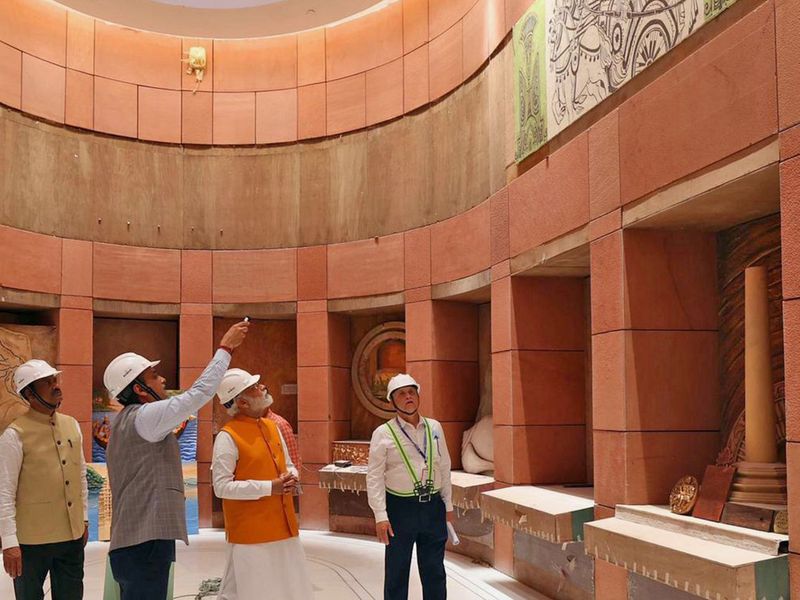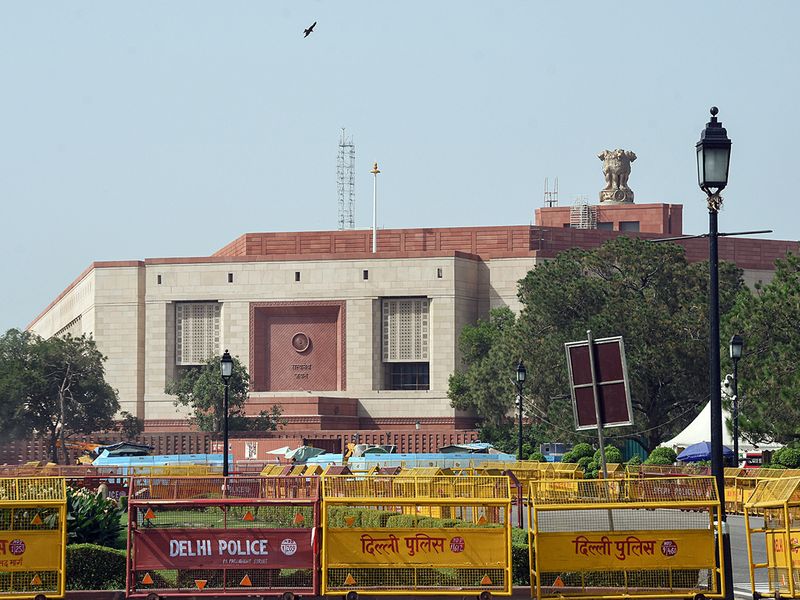
Narendra Modi was sworn in as the 14th prime minister of India on May 26, 2014. Nine years later, he is slated to inaugurate the new Parliament building in New Delhi in the last week of May 2023.
Part of the central vista project, the building is likely to host the monsoon session the parliament which begins in July. Located right next to iconic, circular Sansad Bhavan, or Parliament House, the new four-storey, triangular shaped construction, will boast the state-of-the-art facilities and technology.
The old building, which houses both the upper (Rajya Sabha) and lower (Lok Sabha) chambers of India’s elected representatives, the former indirectly and the latter, directly, was built by the British imperial government of India.
Designed by Edwin Lutyens and Herbert Baker, it was inaugurated in January 1927, part of the massive project of building New Delhi, as the capital of India. It was the seat of Imperial Legislative Council. After independence in 1947, it hosted the Constituent Assembly, and after 1950, when the Constitution came into effect, India’s Parliament.

Eternal tradition
The new parliament building will retain its key location, just 750 metres from the Rashtrapati Bhavan or the presidential palace, and adjacent to the North and South Blocks, where the top echelons of India’s bureaucracy sit, including the Prime Minister’s Office (PMO), and ministries of Home, Defence, Finance, and External Affairs.
It will be the centre piece of the new central vista, which extends from the Rashtrapati Bhavan to India Gate, containing most of the important buildings and administrative divisions of the Government of India.
By the time Modi is finished, whether or not he succeeds fully, he will have changed India significantly, perhaps irrevocably
The foundation stone of the new parliament building was laid by Modi on December 10, 2020, with the original completion date slated for November 2022. But given the magnitude and ambition of the project, the extension of the deadline by a few months is nothing to be frowned upon.
Designed by Bimal Patel of HCP Designs, Ahmedabad, the construction is being carried out by Tata Projects Limited at a cost of over Rs. 1200 crores. The massive building will offer 64,500 sq metres or 694272.22 sq feet of space. It will house some 5000 works of art, representing the “sanatan parampara” (eternal tradition).
The Lok Sabha chamber will have 888, while the Rajya Sabha 384 seats. At its centre will be an open courtyard and a banyan tree, but there will be no central hall, as in the present Sansad Bhavan.
The three-sided building has three main doors, Gyan Dwar (Gateway of Knowledge), Shakti Dwar (Gateway of Power), and Karma Dwar (Gateway of Action), with separate entrances for parliamentarians, visitors, and VIPs.
Its six entrances will feature guardian statues of animals, chosen according to ancient Vaastu shastra and Indian cultural traditions, chosen for their symbolic traits. For instance, the northern door will display the elephant, gaja, representing “wisdom, fortune, intellect and memory.” The horse, eagle, swan, makara, and shardula, the last two being mythical rather than real, will adorn the other five entrances.
One might logically ask what was the need for this expensive, new building? What was wrong with the old one? In an impressive and convincing narrative justifying the project, multiple reasons, under five broad parameters have been offered by the government: “Narrow Seating Space,” “Distressed Infrastructure,” “Obsolete Communication Structures,” “Safety Concerns,” “Inadequate Workspace”..
Glancing through these sections, I found that the first and fifth, “Narrow Seating Space” and “Inadequate Workspace” are similar; the old building was simply too small for an expanding and developing India. Similarly, the second, third, and fourth, namely, “Distressed Infrastructure,” “Obsolete Communication Structures,” and “Safety Concerns,” may also be clubbed together.

Modi’s Monumentalism
The old building needed to be modernised and reinforced, with safety standards and infrastructure brought up to date. A hundred years after it was built, rather than spending an enormous amount of money in its renovation, why not a new building altogether, reflecting the achievement and aspirations of a new India?
The new Lok Sabha will be thrice the size of the present one, with a peacock theme, after India’s national bird. The Rajya Sabha, modelled on the lotus, India’s national flower, will also be much larger. The national three lion Ashokan emblem, in 9500kg of bronze, the lions’ snarl more pronounced, was already unveiled by Modi last July.
There will be more statues inside, this time in granite, with leaders of the freedom struggle. While Gandhi is assured of a place, the same cannot be said of Nehru! In addition, there are to be multiple galleries and foyers. The new Sansad Bhavan will also house a massive, enhanced library, in addition to offices, committee rooms, multiple eating options, and, yes, lots of parking!
Indeed, such an approach has been typical of what I have termed “Modi’s Monumentalism.” It is also evident in other projects like the new Prime Minister’s museum opposite the old Teen Murti House, which housed the Nehru Memorial Museum. Or in the renovations at the Kashi and Mahalkal corridors and theme parks, at Modi’s constituency Varanasi and Ujjain in Madhya Pradesh respectively.
Modi’s monumentalism is also evidenced in mega constructions such as the world’s tallest statue, the Statue of Unity, in the prime minister’s native state, Gujarat. In the same state, the old city of Ahmedabad has a new waterfront with diverted Narmada waters swelling the dried up banks of the local Sabarmati.
Without question, Modi, India’s millennium man, has done more than any leader since Mahatma Gandhi, to reshape India. By the time he is finished, whether or not he succeeds fully, he will have changed India significantly, perhaps irrevocably.











